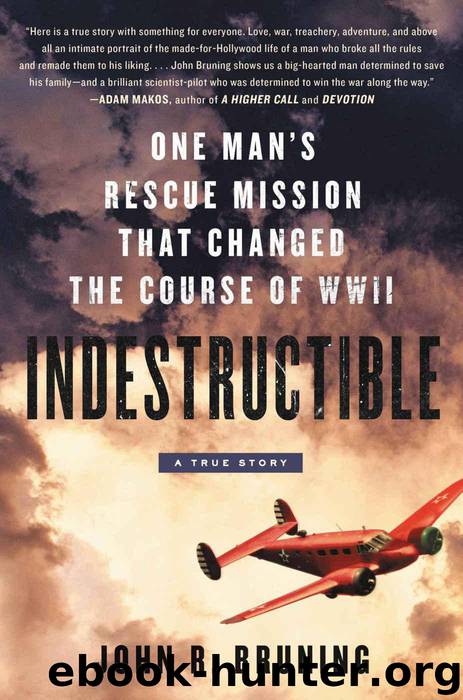Indestructible: One Man's Rescue Mission That Changed the Course of WWII by John R Bruning

Author:John R Bruning
Language: eng
Format: azw3
Publisher: Hachette Books
Published: 2016-10-10T20:00:00+00:00
26
The Canberra Commandos and the Numerous Troubles That Ensued
Early April 1942
Australia
The Dutch were the bastard stepchildren of the Allied cause in the Pacific that spring. In the early days of ABDA Command, many Dutch officers treated the Americans officiously or with aloofness. After navigating all the dangers required just to get to Java, the Americans found this treatment insulting. The relationship between the Allies only deteriorated from there, as the Americans promptly ran roughshod over convention and order, which caused the disciplined Dutch no end of pique.
In battle, the Dutch fought fiercely at times, especially their navy. But their air force engendered a lot of criticism by the Americans for its perceived lack of aggressiveness. Some American officers later alleged that Dutch bombers would sortie against an incoming Japanese amphibious task force, only to jettison their bombs and return to base to report fictionalized heroics.
Gen. Enis Whitehead, who would rise through the ranks to become one of MacArthur’s top air officers, did not mince words about the Dutch. In a 1945 interview, he called them a “shame to the white race.” He added, “No one ever heard of a Dutchman with any guts.”
The characterization was deeply unfair, but it was shared by Pappy and many of the Americans in Australia who fought in the Dutch East Indies Campaign. With the final defeat on Java came further recriminations and contempt from both sides.
Altogether, about nine hundred Dutch servicemen escaped to Australia. Their supreme commander fled to Ceylon, where he set up a new headquarters while putting Maj. Gen. L.H. van Oyen in charge of the refugees in Australia.
ABDA Command dissolved at the end of the Dutch East Indies Campaign in early March. That left the relationship between the Dutch in Australia, MacArthur, and the Australians all very unsettled and complicated. MacArthur seemed to share much of the prevailing sentiment about the Dutch, and when Washington tried to get him to integrate their air units with American ground personnel, MacArthur would not have it. He objected repeatedly until the subject was dropped.
The Dutch in Australia ended up falling between the headquarters cracks. They held their allegiance to the remains of their own chain of command, but their headquarters now lay on the far side of the Indian Ocean without an infrastructure—without even a country, since their homeland surrendered to the Germans in the spring of 1940. This left the Dutch colonial authorities running the show in the Far East. With their colony in Japanese hands, now they were warriors without a home.
The Dutch aircrew ended up as tenants on RAAF bases without any training planes, few instructors, no logistical system to get parts, ammunition, uniforms, or even shoes. In effect, they became wards of the Australian government.
They did have combat planes, and that gave them leverage in this otherwise totally unequal relationship. Before the collapse of Java, the Dutch had paid cash for virtually an entire new air force worth of American combat planes. They were being shipped across the Pacific by the hundred: B-25s and P-40s, light attack bombers and transports.
Download
This site does not store any files on its server. We only index and link to content provided by other sites. Please contact the content providers to delete copyright contents if any and email us, we'll remove relevant links or contents immediately.
| Africa | Americas |
| Arctic & Antarctica | Asia |
| Australia & Oceania | Europe |
| Middle East | Russia |
| United States | World |
| Ancient Civilizations | Military |
| Historical Study & Educational Resources |
The Sympathizer by Viet Thanh Nguyen(4336)
The Rape of Nanking by Iris Chang(4165)
World without end by Ken Follett(3445)
Ants Among Elephants by Sujatha Gidla(3438)
Blood and Sand by Alex Von Tunzelmann(3164)
Japanese Design by Patricia J. Graham(3135)
The Queen of Nothing by Holly Black(2538)
City of Djinns: a year in Delhi by William Dalrymple(2529)
Foreign Devils on the Silk Road: The Search for the Lost Treasures of Central Asia by Peter Hopkirk(2441)
India's Ancient Past by R.S. Sharma(2432)
Inglorious Empire by Shashi Tharoor(2410)
Tokyo by Rob Goss(2403)
In Order to Live: A North Korean Girl's Journey to Freedom by Yeonmi Park(2357)
Tokyo Geek's Guide: Manga, Anime, Gaming, Cosplay, Toys, Idols & More - The Ultimate Guide to Japan's Otaku Culture by Simone Gianni(2344)
India's biggest cover-up by Dhar Anuj(2333)
The Great Game: On Secret Service in High Asia by Peter Hopkirk(2313)
Goodbye Madame Butterfly(2223)
Batik by Rudolf Smend(2150)
Living Silence in Burma by Christina Fink(2047)
